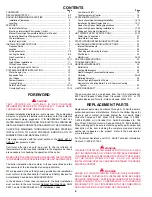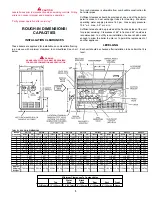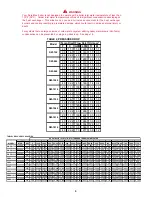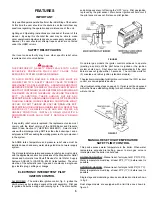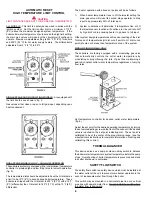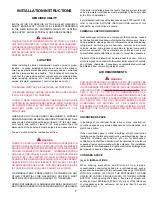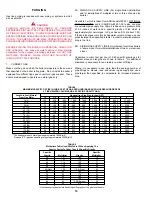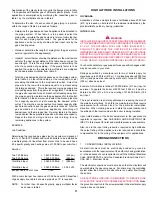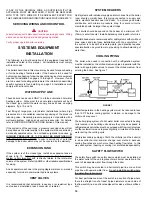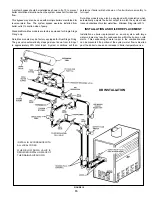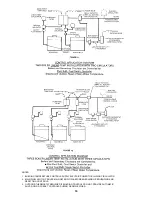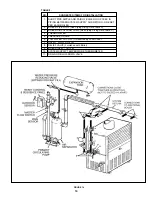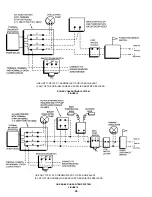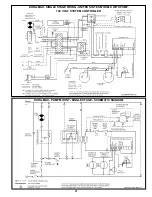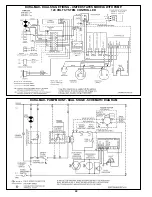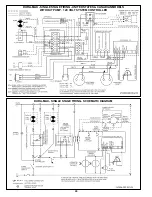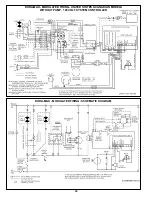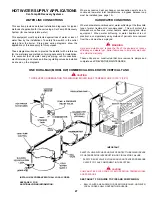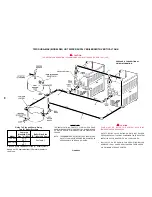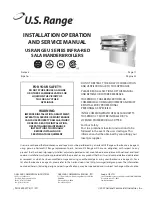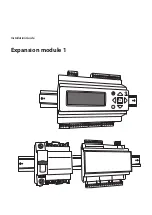
14
Thereafter, during the heating season, lubricate the three oil cups
at least once every four months. Combination heating/cooling
systems or water heating (Cer-temp) systems should be lubricated
every four months year-round.
Use 2 or 3 teaspoonfuls in bearing oil cups, fig. 9, and 10 or 12
drops in the motor oil cups. Use No. 20 non-detergent motor oil.
Follow the same oiling procedure if a replacement circulator is
installed into the system.
LOW WATER CUTOFF
A low water cutoff is a safety device which is installed in the boiler
piping to prevent the boiler from firing in the event of inadequate
water levels in the boiler system.
Where required by local code, this optional device is to be installed
in the boiler piping at a level above that of the heat exchanger.
A float type or an electronic probe type low water cutoff may be
used. The manufacturers installation instructions must be followed.
A hot water boiler installed above radiating level or as required by
the Authority having jurisdiction, must be provided with a low water
cutoff device at the time of boiler installation.
TANK TEMPERATURE CONTROL
The water temperature in the storage tank is controlled by the Tank
Temperature Control. The sensing element is mounted inside the
hot water storage tank, see fig. 24.
DANGER
HOT WATER TEMPERATURES REQUIRED FOR AUTOMATIC
DISHWASHER AND LAUNDRY USE CAN CAUSE SCALD
BURNS RESULTING IN SERIOUS PERSONAL INJURY AND/OR
DEATH. THE TEMPERATURE AT WHICH INJURY OCCURS
VARIES WITH THE PERSON'S AGE AND TIME OF EXPOSURE.
THE SLOWER RESPONSE TIME OF CHILDREN, AGED, OR
DISABLED PERSONS INCREASES THE HAZARDS TO THEM.
NEVER ALLOW SMALL CHILDREN TO USE A HOT WATER TAP
OR TO DRAW THEIR OWN BATH WATER. NEVER LEAVE A
CHILD OR DISABLED PERSON UNATTENDED IN A BATHTUB
OR SHOWER.
THE WATER HEATER SHOULD BE LOCATED IN AN AREA
WHERE THE GENERAL PUBLIC DOES NOT HAVE ACCESS TO
SET TEMPERATURES.
The tank temperature control is adjustable from 100°F to 220°F
(38°C to 104°C). It is recommended that lower water temperatures
be used to avoid the risk of scalding. It is further recommended, in
all cases, that the water temperature be set for the lowest
temperature which satisfies the user's hot water needs. This will
also provide the most energy efficient operation of the water heater
and minimize scale formation.
SETTING THE WATER TEMPERATURE AT 120°F (49°C) WILL
REDUCE THE RISK OF SCALDS. Some states require settings at
specific lower temperatures. Table 6 below shows the approximate
time-to-burn relationship for normal adult skin.
Temperature
Time to Produce 2nd & 3rd
Setting
Degree Burns on Adult Skin
Over 170°F (77°C)
Nearly instantaneous
160°F (71°C)
About 1/2 second
150°F (65°C)
About 1-1/2 seconds
140°F (60°C)
Less than 5 seconds
130°F (55°C)
About 30 seconds
120°F or less (49°C)
More than 5 minutes
TABLE 6
USE ANTI-SCALD VALVE(S) in the hot water system to reduce the
risks of scalds at points of use such as lavatories, sinks and bathing
facilities.
A change in water temperature in the storage tank lower than the
Tank Temperature Control setting will cause the sensor to close its
contacts and consequently, energize the boiler.
If the Tank Temperature Control is out of calibration, replace it with
a new one; do not attempt to repair this control.
SYSTEM INSTALLATION
GENERAL
If the system is to be filled with water for testing or other purposes
during cold weather and before actual operation, care must be taken
to prevent a downdraft entering the boiler or freezing air from
contacting the system. Failure to do so may cause the water in the
system to freeze with resulting damage to the system. Damage
due to freezing is not covered by the warranty.
Good practice requires that all piping, etc., be properly supported.
CONVENTIONAL SPACE HEATING INSTALLATION
Modern fin type boilers are exceptionally fast heating units. The
low water volumes in relation to firing rates require special attention
to water flow rates for smooth, efficient operation. These
considerations for the A. O. Smith copper heat exchanger boilers
are covered below.
Refer to page 5 for tables on these units showing “flow rate vs.
pressure drop and temperature rise”.
Figure 10 shows a typical installation of the boiler.
A system with several flow controlled zones, or with a 3-way mixing
valve system which could present a flow rate to the boiler of less
than that required for a maximum of 50°F (10°C) temperature rise
at the minimum firing rate, should be designed with compensating
bypasses at the boiler.


